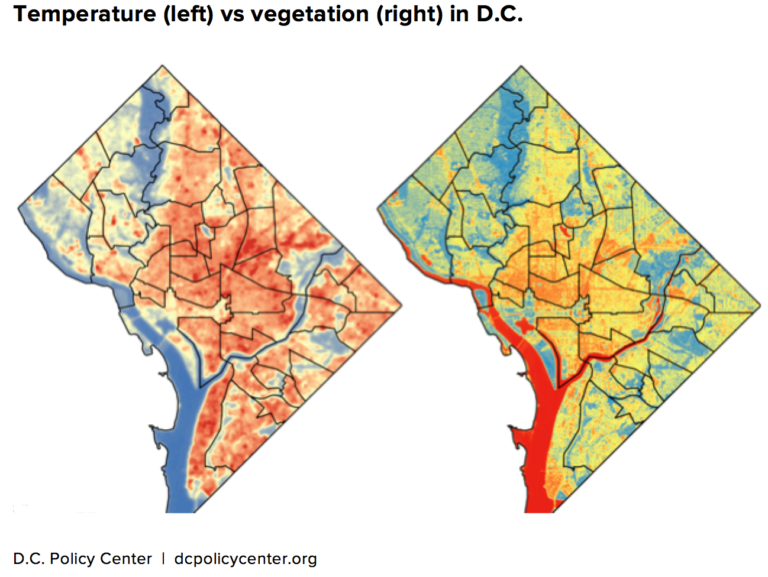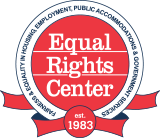Where The Grass Is Greener: Disparities in Access to Parks and Trees
By: Hana Cho and Nick Adjami
June 24, 2025
Summer in D.C. is hot! But some parts of the District are hotter than others. Places like Kingman Park in the city’s Northeast quadrant can reach temperatures up to 10 degrees higher than their neighbors. These areas are known as heat islands: urban areas that experience higher temperatures than other parts of a city.
One thing the hottest neighborhoods in D.C.—and in cities across America—have in common is a lack of green spaces. Green spaces like parks are a key ingredient for preventing heat islands, and they’re not distributed evenly across the city. They’re less likely to be found in low-income neighborhoods and communities of color, which are often neglected by city planners, elected officials, and government agencies. Residents of these neighborhoods are put at increased risk of suffering the harms of heat exposure, and those risks increase every year as the climate continues to warm.
What are green spaces?
Green spaces are areas in a city covered by vegetation, such as parks and tree-lined sidewalks. These spaces are vital to urban communities. During extreme heat, green spaces cool the surrounding area. Even the canopy from individual trees can keep temperatures cooler by 2.5 degrees. In the image below, the map on the left depicts the temperature range on a summer day in D.C., red representing higher temperatures and blue representing lower temperatures. The map on the right shows where the city’s green spaces are, red being low concentrations of vegetation and blue being high concentrations of vegetation. Comparing the two, it’s clear that heat is strongly correlated with a lack of green space.

Credit: D.C. Policy Center, https://www.dcpolicycenter.org/publications/urban-heat-islands/
How housing policy shaped access to green spaces
The Fair Housing Act of 1968 made it illegal to discriminate in housing nationwide. Before the law’s passage, people of color were legally segregated to less desirable neighborhoods. Racial segregation was underpinned and upheld by federal policies and practices. For example, the Home Owners Loan Corporation drew color-coded maps to categorize neighborhoods by investment risk. Neighborhoods with a high concentration of Black residents were “redlined” and denied financial services.
The effects of this disinvestment are reflected in the lack of infrastructure, including green spaces, in historically redlined communities today. Instead of building and improving facilities for the residents of these communities, governments and corporations often view them as sites for other projects that can bring further harm to the neighborhood, like highways, factories, and chemical plants. These projects tend to lead to pollution, flooding, and other hazards that ultimately affect residents’ health and quality of life.
Current disparities in access to green spaces
Across America, people of color are three times more likely to live in “nature-deprived” areas than their white counterparts. Parks in communities of color tend to be half the size and serve five times more people compared to parks in majority-white neighborhoods.
For areas without space for parks or gardens, even street trees provide green space. However, many low-income neighborhoods are losing their trees to development projects. Government and private corporations have displayed a pattern of sacrificing low-income communities for construction. A recent study found that Ward 8 in Southeast D.C. lost more healthy trees to development than any other ward.

Credit: Washington City Paper, https://washingtoncitypaper.com/article/764918/tree-canopy-development-talbert-terrace/
Unequal access to green spaces has serious consequences
When parking lots replace parks and trees are cut down, temperatures rise. And extreme heat can be deadly. Factors like age and disability are linked to income, meaning residents of heat islands are often most at risk of the adverse effects of extreme heat. For example, heat can worsen symptoms for people with asthma, and seniors face a greater risk of experiencing heat stroke. Green spaces are one way to combat extreme heat and mitigate these risks, and the benefits don’t stop there. Green spaces also improve air quality, reduce stormwater runoff, and promote the physical and mental health of the surrounding community.
Everyone deserves access to nature and its benefits, but unequal distribution of parks and trees isn’t the only barrier: upkeep matters too. Parks in lower-income areas are often poorly maintained, preventing residents from enjoying them fully. For example, despite D.C. receiving top ranks for the “best big-city park system” in America for the 5th year in a row, parks in predominantly Black and low-income neighborhoods like Wards 7 and 8 have less equipment and aren’t as well kept as parks in wealthier areas. They’re also harder to get to. Many residents would need to cross a highway to even reach the nearest park. In Ward 8’s Anacostia neighborhood for example, Interstate 295 blocks off safe access to green space.
Promoting fair housing and green space access in D.C.
The Anacostia River represents a racial and economic dividing line in D.C. The 11th Street Bridge Park seeks to literally bridge that divide by connecting majority-Black Ward 8 east of the river with Ward 6, a predominantly white community west of the river with more than double the median income. The 11th Street Bridge Park would be a public recreational space right on the water. The nonprofit organization behind the park, Building Bridges Across the River, anticipates building playgrounds, classrooms, and plenty of green space. The plans include stretches of grassy lawn, shade trees, plots for urban agriculture, and multiple gardens.
The project includes community input from Ward 8 residents who raised concerns about how the bridge might negatively impact their homes. When desirable development is built in low-income neighborhoods, lifelong residents and small businesses are often priced out of their community. In an effort to offset that possibility, Building Bridges Across the River developed an “Equitable Development Plan” that includes investing in the Ward 8 community. They hope the project will become a model for equitably bringing infrastructure and green spaces to disinvested communities across the country.
So, as temperatures climb this summer, remember how heat varies by neighborhood and that these disparities are man-made. Parks and trees aren’t just nice to look at, but key components of a healthy community, with benefits that everyone deserves access to.
___
The ERC is a civil rights organization that identifies and seeks to eliminate unlawful and unfair discrimination in housing, employment and public accommodations in its home community of Greater Washington DC and nationwide. The ERC’s core strategy for identifying unlawful and unfair discrimination is civil rights testing. When the ERC identifies discrimination, it seeks to eliminate it through the use of testing data to educate the public and business community, support policy advocacy, conduct compliance testing and training, and, if necessary, take enforcement action. For more information, please visit www.equalrightscenter.org.
The work that provided the basis for this publication was supported by funding under a grant with the U.S. Department of Housing and Urban Development. The substance and findings of the work are dedicated to the public. The author and publisher are solely responsible for the accuracy of the statements and interpretations contained in this publication. Such interpretations do not necessarily reflect the views of the Federal Government.

